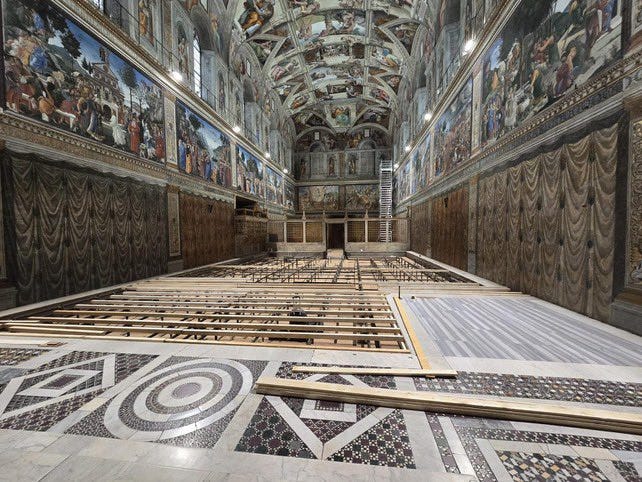Secrecy in the Sistine Chapel
Ancient rituals and new tech collide in the Vatican’s most important private vote.
Welcome to the weekday free-edition of this newsletter that is a small idea, an actionable tip, or a short insight that takes less than 5 minutes to read. On Sundays, I write in-depth technical deep-dives on many aspects of semiconductors and chip design for paid subscribers of this publication. Vik’s Newsletter is a reader-supported publication. See all the benefits of upgrading your subscription tier!
If you would like to suggest a topic for this newsletter, please use this form.
Today, the College of Cardinals has gathered in the Sistine Chapel in Vatican City to vote on who will be the next earthly head of the Catholic Church, the Pope. This papal conclave, which is derived from cum clave, Latin for with a key, dictates that the cardinals are locked away in seclusion to ensure that the voting process is not influenced by political or religious motivations.
The process of electing the new Pope is notoriously secretive, and the extent of measures taken to avoid outside influence is extreme. This ritual of secrecy goes back to 1274 when Pope Gregory X set the rules for how conclaves must be held, whose own election was the longest election in history spanning over 1,006 days. The local residents threatened to cut off food to the cardinals if they did not reach a decision.
In what might be the earliest form of cybersecurity, for 750 years, there have been strict rules on what cardinals can and cannot eat. Things like chicken, ravioli and pies are forbidden to prevent secret messages from being hidden in them. For this conclave, food will be prepared by nuns and the menu will consist of minestrone, spaghetti, lamb skewers and boiled vegetables.
Announcing whether a new Pope has been elected or not still uses the most rudimentary binary signaling — smoke signals. White smoke if the Pope has been chosen; black smoke if the two-thirds majority was not met.
During the 2013 conclave that elected Pope Francis, newer 21st-century security measures were allegedly deployed. NBC reports that there was a false floor installed in the Sistine Chapel equipped with electronics that jammed RF signals in the chapel. There are unverified photos of this false flooring on the internet too.
There were some reports that the Sistine chapel was fitted with Faraday cages, although this is hard to believe. A Faraday cage is a metal shield that works by inducing currents on the metal exterior to cancel any electromagnetic fields inside the cage. But this only works if the entire Sistine chapel was somehow enclosed in a metal box, and putting in a false ceiling is a noticeable addition I would think. There are also conspiracy theories that the tiles in the chapel have somehow been replaced with RF blocking ones.
Short of covering the cardinals in conductive cloth or painting over the beautiful chapel with graphite-based black colored RF-blocking paint (which actually works quite well when Linus Tech Tips tested it), blocking RF signals completely is a hard engineering problem because of the number of different bands that radio devices communicate in (GPS, cellular, bluetooth, WiFi, etc.) The most obvious method, which the Vatican police have already adopted, is to completely scan and remove any possible communication devices and bugs planted in the chapel for snooping on the papal proceedings.
The secrecy behind the whole affair makes any claims of the use of technology difficult to actually verify. In a world where we pride ourselves in our ability to stay connected to each other, the conclave stands out as a curious exception where we try to undo all technological progress for a thousand years.
Meanwhile, I'll just wear my tin-foil hat and go watch this movie instead.



